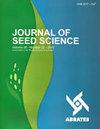大豆种子大小:如何影响作物发育和种子生理品质?
IF 1.2
4区 农林科学
Q3 AGRONOMY
引用次数: 1
摘要
摘要:大豆种子大小与生理品质、田间栽培和产量之间的关系存在争议,需要进一步研究。本研究旨在探讨种子大小对大豆结实和种子生理品质的影响。在田间,采用2 × 3 × 3因子设计,选用2个品种(M 5947 IPRO和59HO124 IPRO), 3种种子大小(5.5、6.0和6.5 mm), 3种播种密度(28万、32万和36万株。ha-1)。对籽粒产量和农艺性状进行评价。收获后,使用5.5 mm、6.0 mm、6.5 mm和7.0 mm孔径的圆筛对32万株种子进行大小分类。生理品质评价采用2x4因子设计,选用2个品种和4种种子大小。对发芽、出苗、加速老化、幼苗干物质和出苗速度指数进行评价。种子越小,植株越矮,首荚插入高度越低。种子越大,生理品质越好。m5947 IPRO品种表现出较好的种子性能和品质。本文章由计算机程序翻译,如有差异,请以英文原文为准。
Soybean seed size: how does it affect crop development and physiological seed quality?
Abstract: The size of soybean seeds needs further study because its relationships with physiological quality, field establishment, and yield are controversial. The aim of this study was to evaluate the effects of seed size on soybean establishment and seed physiological quality. In the field, a 2x3x3 factorial design was used, with two cultivars (M 5947 IPRO and 59HO124 IPRO), three seed sizes (5.5, 6.0, and 6.5 mm), and three sowing densities (280,000, 320,000, and 360,000 plants.ha-1). Agronomic traits and grain yield were evaluated. After harvest, only seeds from plots with a population of 320,000 plants were classified by size using circular sieves with 5.5-mm, 6.0-mm, 6.5-mm, and 7.0-mm mesh sizes. For the evaluation of physiological quality, a 2x4 factorial design was applied, with two cultivars and four seed sizes. Germination, seedling emergence, accelerated aging, seedling dry matter, and emergence speed index were evaluated. Smaller seeds gave rise to shorter plants with a lower first pod insertion height. Larger seeds had higher physiological quality. The M 5947 IPRO cultivar showed better seed performance and quality.
求助全文
通过发布文献求助,成功后即可免费获取论文全文。
去求助
来源期刊

Journal of Seed Science
Agricultural and Biological Sciences-Agronomy and Crop Science
CiteScore
2.00
自引率
30.00%
发文量
28
审稿时长
12 weeks
期刊介绍:
From 2017 the Journal of Seed Science (JSS) will circulate online version only.
Original scientific studies and communications, not yet published or submitted to another journal for publication and written in Portuguese or English, will be accepted for publication. For manuscripts submitted in English, the authors should provide an adequated version.
The SCIENTIFIC COMMUNICATION is a category of scientific manuscript which describes a technique, an equipment, new species or observations and surveys of limited results. It has the same scientific rigor as the “Scientific Articles” and the same value as a publication. The classification of a manuscript as a SCIENTIFIC COMMUNICATION is based on its content and scientific merit but it can be a preliminary study, simple and not definitive on a certain subject, with publication justified by its uniqueness and contribution to the area.
The Editorial Board of the JSS may invite leading authors of recognized reputation to compose specific Review Articles covering topics of their specialization that will convey to the scientific community the state-of-the-art knowledge related to the specific theme.
 求助内容:
求助内容: 应助结果提醒方式:
应助结果提醒方式:


